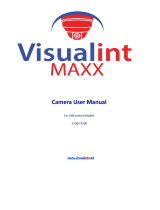
Version 180605-1431
Technical Bulletin
Visualint
Install Guide for IR-Enabled Dome Cameras
Static and PTZ dome cameras alike have a clear covering to protect the camera lens and gear. While this provides
many benefits, it also creates some potential installation issues not normally associated with surveillance cameras.
This guide walks you through those, how they occur, and how to avoid them.
Considerations
Most dome cameras are installed under the eaves of a roofline. The surfaces of the soffit and wall can cause infrared
reflection issues.
When installing under an eave, the camera should be 6” or less from the edge of the roof, whether the edge is
defined by the soffit or a gutter.
Similarly, because they can swivel, PTZs are often mounted at the corner of the roof, where there is often a
downspout from the gutter. The PTZ should also be mounted at least 6” away from a downspout.
Internal testing has shown that a camera lens tilt of 13° avoids noticeable soffit glare. Similarly, the camera should
be turned 34° away from a wall or downspout to avoid IR reflection.
Do not install the camera so that it faces the sun directly. This prevents potential daylight reflections.
With difficult installs, use a pendant or arm mount to improve your results.
Tilt Test: Soffit Glare
With camera at 0° tilt, a halo of
infrared reflection is noticeable in
the live view. You can see some of its
effects at the top of this snapshot; the
sky and nearby roof are unnaturally
light.
From 0° tilt to around 10° the IR
reflection is still there, though it
diminishes as the camera is tilted
further down.
With the camera tilted down between
11°–13°, the reflection disappears and
image looks good.


















